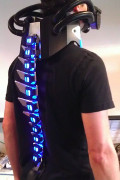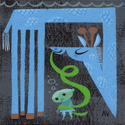|
We don't have any dog parks, but all of the rest I do. We go for runs, fetch in my huge back yard, fetch in the house. He's down for pretty much anything. Update: We dialed it back to half a cup, and he has eaten every meal without issue. He seems much happier to eat as well. I'm still giving him the mid-afternoon snack and he takes that gladly. I think we were just feeding him too much. Thanks, everyone. 
|
|
|
|

|
| # ? May 31, 2024 11:49 |
|
get out posted:We don't have any dog parks, but all of the rest I do. We go for runs, fetch in my huge back yard, fetch in the house. He's down for pretty much anything. That's probably a little on the short side. The math indicates a little under 1.5 cups would be better on the food you're using. Monitor him closely over the coming weeks and adjust as needed.
|
|
|
|
We were just shy of one cup per feeding and that seemed to be way too much for him. Do you think I could increase it over the next few weeks without him reverting back to his bullshit of ignoring food for days?
|
|
|
|
We got an 8 week old 3/4ths poodle 1/4th golden retriever (whatever the gently caress you call them) girl puppy about three weeks ago. We have two Golden Doodles, one 2 years old and around 110 pounds, one a year and half around 45 pounds. She's a sweet girl when you play with her, there's just one problem: She's a complete loving nutcase that bites and destroys everything. She won't stop biting both our dogs, she's not afraid of either even when they bite or fight her back. She's 14 pounds and she takes down my 110 pound dog like its nothing, then gets on his stomach and bites him in the face. When she's not destroying our dogs, she's destroying everything around her. She'll chew on anything that's not a toy and somehow managed to rip my carpet from the floor boards despite being 14 pounds and being left alone for all of 20 seconds. She is also incredibly disobedient; despite three weeks of focusing on making her come when called, she will only do the exact opposite of coming. We've tried a few techniques. I've sprayed the wires under my computer with bitter apple, and sprayed the bitter apple on most of her favorite chew spots. This, it seems, only makes her want to eat it more. She doesn't learn from getting her nose squeezed and she's not afraid of pretty much anything (vacuums, rolled up newspapers, a bear that wandered into our back yard). We've started squeezing her nose the second she does anything wrong and all it makes it do is bite our dogs or chew on stuff immediately after we do it. We've also tried plying her with these half-calorie treats every time she does anything good, but it's not teaching her to follow any command. We're almost out of ideas and we're about to give the dog away. I really don't want to do that, I believe the next family will just throw her into the pound when they realize what a little oval office she is. What should we do? Edit: Oh and one other thing, she drinks water and pee's constantly. The second you let her out of the crate she'll drink as much as she can get. We were playing for twenty minutes and she pee'd twice. We're doing ok with house training but sometimes she just can't help it. Doltos fucked around with this message at 19:44 on Oct 18, 2012 |
|
|
|
MrFurious posted:That's probably a little on the short side. The math indicates a little under 1.5 cups would be better on the food you're using. Monitor him closely over the coming weeks and adjust as needed. The calculator said 1.5 cups for Psyche as well and she was gaining weight on 1 cup a day. I'm not sure it's all that accurate and I would think that breed would make a difference too. If you're worried about it, then weighing the dog to watch for a trend is to the way to go. Also, watch for lethargy or any other signs of problems, of course.
|
|
|
|
Get Out I would see how he does with the amount you are giving him right now for a week. If he is seeming skinnier or like he's totally starving and searching for food endlessly I would increase it a bit and then just keep evaluating him on a weekly basis for a while. I would keep track of his weight either at home with a household scale or taking him to the vet for a weigh in (usually free and welcomed by vets) on a regular basis until you get his food issues sorted out. For everyone else, I know Denise Fenzi comes up a lot and she is having an online class on improving play skills here. The "observer" price is only $75 and its six weeks long. I'm definitely going to see if I can scrape up the cash because I find her blog so helpful for improving my relationship and motivation skills with my beast. I also need to pay for my next session of reactive dog class and my yearly checkup with the vet behaviorist soon though so we'll see.
|
|
|
|
Doltos posted:We got an 8 week old 3/4ths poodle 1/4th golden retriever (whatever the gently caress you call them) girl puppy about three weeks ago. We have two Golden Doodles, one 2 years old and around 110 pounds, one a year and half around 45 pounds. She's a sweet girl when you play with her, there's just one problem: Have you tried perhaps exercising your puppy?? Read up the housetraining FAQ (in the new dog/puppy thread, I think), follow that. Have more structured playtime. Don't "force" her to come when called. Use NILIF to teach her self control. Use her kibble at mealtimes to work her brain and teach her things. Don't squeeze your dog's nose. It's stupid and won't teach her a thing, as you've seemingly already seen.
|
|
|
|
get out posted:We were just shy of one cup per feeding and that seemed to be way too much for him. I'd try to bust his nervousness or whatever it is before you increase his food too much. I would want to keep him slightly hungry so as to decrease the odds of him falling back into old, frustrating habits.
|
|
|
|
Doltos posted:We got an 8 week old 3/4ths poodle 1/4th golden retriever (whatever the gently caress you call them) girl puppy about three weeks ago. Your dog missed critical socialization with her mother and littermates by being taken home at 5 weeks. That is why she bites everything and has no social skills with your other dogs. Please read the puppy thread and get her in to a good puppy k class as soon as possible. vv Durr, reading comprehension issue. Sorry. I still suggest puppy k and the puppy thread though. vvv Instant Jellyfish fucked around with this message at 20:25 on Oct 18, 2012 |
|
|
|
Instant Jellyfish posted:Your dog missed critical socialization with her mother and littermates by being taken home at 5 weeks. That is why she bites everything and has no social skills with your other dogs. Please read the puppy thread and get her in to a good puppy k class as soon as possible. She's 11 weeks, we got her 8 weeks old 3 weeks ago.
|
|
|
|
Doltos posted:She won't stop biting both our dogs, she's not afraid of either even when they bite or fight her back. She's 14 pounds and she takes down my 110 pound dog like its nothing, then gets on his stomach and bites him in the face. When she's not destroying our dogs, she's destroying everything around her. She'll chew on anything that's not a toy and somehow managed to rip my carpet from the floor boards despite being 14 pounds and being left alone for all of 20 seconds. She is also incredibly disobedient; despite three weeks of focusing on making her come when called, she will only do the exact opposite of coming. Dogs do the things that are rewarding to them and practice makes perfect. If your dog is chewing on everything and biting your other dogs, then you need to limit access until you can teach better habits. Use tethering, crates, or ex-pens to control her environment when you are not directly interacting with her. Up her exercise a ton, as a tired doggie is a good doggie. For teaching her a recall, do you ever punish her for not coming immediately? Does her coming to you mean bad things happen, like play time is over? These are common mistakes that typically ruin a recall. quote:
Some dogs like bitter apple spray. Squeezing her nose isn't going to work because she doesn't understand what she is being punished for (and may not even see it as a punishment) and she is still being reinforced for the other things she does. Dogs get to choose what treats they like, so if she doesn't respond to the treats you are using, find something she does like. Redirecting onto appropriate toys done consistently will teach her not to chew and removing reinforcement for biting will teach her not to bite. We can tell you how to do these things, but I'm not going to lie and say they are easy. A puppy trainer will make the process go smoother. quote:
Puppies need to pee often and even young adult dogs will often need to go outside after a play session or eating. If you seriously think she can't help it, then she may have a medical problem. Otherwise, the puppy thread has a really nice guide for housebreaking. Edit: fixed my quotes!
|
|
|
|
Kiri koli posted:Dogs do the things that are rewarding to them and practice makes perfect. If your dog is chewing on everything and biting your other dogs, then you need to limit access until you can teach better habits. Use tethering, crates, or ex-pens to control her environment when you are not directly interacting with her. Up her exercise a ton, as a tired doggie is a good doggie. Thanks a ton for this. The recall is almost always for the end of play time, which is usually why she runs away. We've tried a variety of things: vinegar, bitter apple, this stuff called doggy goo that smells awful. She eats it all and loves it. We also crate her when she's being bad, but we don't want to associate the crate with punishment since she spends time in there every night and for a few hours at a time during the day. Oh and we definitely need to exercise her more. We only do about 2 or 3 hours of play a day.
|
|
|
|
Doltos posted:Thanks a ton for this. The recall is almost always for the end of play time, which is usually why she runs away. We've tried a variety of things: vinegar, bitter apple, this stuff called doggy goo that smells awful. She eats it all and loves it. We also crate her when she's being bad, but we don't want to associate the crate with punishment since she spends time in there every night and for a few hours at a time during the day. You'll probably have to start over with the recall and make sure that it signals good things, like rewards and more playtime, more often than an end to playtime. If you plan to do a collar grab or attach a leash at the end of playtime (say at a dog park), then you need to practice this as well. You can switch things up on her by adding something like a hand touch as a recall if she's completely decided that coming when called = baad. If you already have a cue, then I would drop using it and just reward her for coming to you whenever she does. For example, I take my dog outside on a long line and just walk around. She gets a treat whenever she comes to me. Or I will get her attention by jumping around and when she heads over to see what's up, I call her name and reward her. These types of behavior need to be pretty solid before you start adding cues and using it in real situations, otherwise it won't stick. In general, at the beginning, you have to make sure that YOU are more interesting then the environment, so start in a boring place and make sure she knows that you = treats/praise/toys/whatever she likes and other stuff = boring. After you build a strong reinforcement history, then you can add in distractions. Definitely don't use the crate as a punishment. If tethering isn't good enough, than I would suggest a timeout spot, such as a boring bathroom.
|
|
|
|
So apparently I have a student for my class tomorrow! Yay! Someone bought their 90 year old mother a five month old sheltie!! What can go wrong with that! I don't know who the human is that will be in my class, the very old lady or her slightly less old son. I do not know who is going to be around this dog or if this lady lives alone or who will see that it is exercised and cared for. Why do you not go get some adorable fat 6 year old lump of a cuddlepup from the local rescue that will be happy being pet all day and not moving? Why do you get a puppy? Argh!
|
|
|
|
|
Doltos posted:Thanks a ton for this. The recall is almost always for the end of play time, which is usually why she runs away. We've tried a variety of things: vinegar, bitter apple, this stuff called doggy goo that smells awful. She eats it all and loves it. We also crate her when she's being bad, but we don't want to associate the crate with punishment since she spends time in there every night and for a few hours at a time during the day. I'm currently raising a 10 week old working border collie puppy, so I know very well what it can be like with an energetic puppy in the house. Energetic, bitey, annoying puppies which destroy everything grow up to become the best dogs, but you need to be nearly endlessly patient. It's worth it though, I promise! Here's what I do with inappropriate biting and barking (more like screaming with my puppy, he has the most horrible voice of any dog ever): I pick the puppy up and hold him until he's quiet and calm. Then I set him down and little by little loosen my gentle but firm grip on him. If he stays even for one moment without bolting, I tell him he's ok to go. There are a few tricks for this approach to work. First, you must make sure the consequence always follows immediately. If the pup hides under the bed, I go get him. Second, you want to make sure you reaching for the puppy doesn't turn into something that predicts trouble and negative things. I make sure to reach for my puppy in a similar way whenever I give him a treat, pet him or invite him to play with me. Nice things follow me reaching for the pup 90% of the time, if not more. Once the puppy grows to be too big for me to comfortably pick him up, I use the bathroom as a time-out space. Third, you must never ever give in. Every time you let the puppy go before he's calmed down, he'll take longer to calm down next time. Every time you wait him out, he'll take a little less time to calm down next time. I deal with chewing inappropriate things by limiting access and providing lots of appropriate alternatives to chew on. Limiting access means I've fenced off most of our furniture with wire fencing. I expect them to be there for 6-12 months, depending on how the puppy is doing. They're not pretty, but I like my stuff (and my puppy, some of my stuff is dangerous to him). I can't leave chew bones or bully sticks out because of my two other dogs, but I do have lots and lots of Nylabone type things, Kongs and birch logs around. I know some people disagree with letting a dog chew wood, but I'd rather give them that than my wooden furniture. When my oldest dog Pi was little, I'd let him keep some of the sticks he carried in from walks and he'd chew those. This depends on the dog of course: if any of my dogs actually ingested significant amounts of wood, I wouldn't do it. You also need to keep an eye on their gums and mouth becaus splinters can be an issue, though I never had problems. As for the peeing, I'm fairly sure my puppy condenses water out of the air and turns it into pee. It's the only way to explain it. (Puppies pee often. It'll get better as she matures. If you're concerned see a vet to rule out UTI.) Edit. I must add that 11 week old puppies CANNOT be disobedient. She's a baby and is very much still learning. If she doesn't comply with something you ask of her, you need to train her more. (This way of thinking is good even when she's grown up, too.)
|
|
|
|
Doltos posted:She won't stop biting both our dogs, she's not afraid of either even when they bite or fight her back. She's 14 pounds and she takes down my 110 pound dog like its nothing, then gets on his stomach and bites him in the face.  ) two weeks ago. Afaik he was pretty tired after our visit.) ) two weeks ago. Afaik he was pretty tired after our visit.)
|
|
|
|
Did anyone in here go to APDT? If so maybe you saw me selling books? I was taking money and trying to avoid anyone asking me questions that I probably couldn't answer. Curious what people thought of the speakers/presentations they saw. It seemed like VanFleet's and Garrett's stuff were really popular.
|
|
|
|
Patricia McConnell posted up a summary of one of her recent seminars on dog reactivity, and I wanted to link it and copy/paste it into this thread. I think I'll also link it in the OP as a basic summary of how to address reactivity problems. Original link to Patricia McConnell's blog here: https://www.patriciamcconnell.com/theotherendoftheleash/dog-dog-reactivity-treatment-summary quote:Dog-Dog Reactivity – Treatment Summary Thoughts?
|
|
|
|
Pretty good writeup. We do almost all #2 in dog reactive classes because most of the owners really aren't very dog savvy and that's part of why they're having problems in the first place. I try to do #3 for people greeting with my own dog because she is such an exuberant greeter.
|
|
|
|
A good summary. I think that options 1, 2, and 3 are very important foundational techniques and that all owners with reactive dogs should be aware of them and make an effort to be the advanced trainers who are an expert in their dogs' body language that moving from 1-3 requires. Even if, say, BAT is not the best technique for your particular dog, I don't think it's easy to make that call without trying it, which, of course, requires you to try it correctly and be a good enough trainer to do so. I've never really seen 4 in action and I'm always skeptical of techniques that just require the dog to be bothered when the handler leaves, but that's probably just because my dog couldn't care less! As I've said before, in my particular case, we made very efficient progress once we implemented pressure-on/pressure-off approaches ala Brenda Aloff, which, to me, encompass BAT and CAT but also include more techniques and a broader philosophy for managing the life of a dog with poor communication and coping skills. But that's maybe getting too complicated for a summary.
|
|
|
|
I think sometimes novice trainers (like me!) with reactive dogs might start out with 1 and move on to 2. I counter conditioned Bailey like crazy, making treats rain down when cars came by. As he began to react from father distances, I also asked for a sit (looking at me) and then would treat. Often times he sees a car coming now, and if he's not surprised he'll offer a very nice sit with great eye contact. I think those are probably the two easiest ways to train for something where the other dog/ object/ person isn't stationary and might approach.
|
|
|
|
I have a temporary foster dog who is a decent dog, except for being extremely food aggressive. I feed him and Max separately to avoid fights and keep all bones and treats away from them, but the food aggression extends to MY food. As in, if I'm sitting on the couch having a snack and Max comes up to me to supervise my eating as all dogs do, Charlie (foster dog) will attack him. I really don't want to have to crate both dogs every time I want a snack. I'm hoping to rehome Charlie ASAP so in theory this will be a short-lived temporary problem, but what the hell can I do in the meantime?
|
|
|
|
Aquatic Giraffe posted:I have a temporary foster dog who is a decent dog, except for being extremely food aggressive. Given the reason you are holding on to him for the time being, I feel like you should really evaluate whether or not there are going to be many homes where he'll fit in very well and maybe do a through check for other behavioral issues. I'm just saying! That aside, for the time being, any behavior like this can get worse if its allowed to be practiced, so its probably best to crate or confine one or both dogs during meal times and if you have a snack, maybe take it or eat it in a room where the dogs can't see you?
|
|
|
|
wtftastic posted:Given the reason you are holding on to him for the time being, I feel like you should really evaluate whether or not there are going to be many homes where he'll fit in very well and maybe do a through check for other behavioral issues. I'm just saying! That's what I'm worried about  I'm going to ask around at my agility class on Monday since a lot of them have relatives and friends with farms (he seems like he'd be an excellent farm dog) and a couple other people are asking around. I don't mind hanging on to him for a little while to work on some of his issues, but it wouldn't be an ideal situation since Charlie is BIG and is only going to get bigger and my apartment is only so big. The reason I haven't just taken him to the shelter is because if I say the reason he's being surrendered is because he scares kids it's an instant death sentence for him, and all the no kills are full. I'm going to ask around at my agility class on Monday since a lot of them have relatives and friends with farms (he seems like he'd be an excellent farm dog) and a couple other people are asking around. I don't mind hanging on to him for a little while to work on some of his issues, but it wouldn't be an ideal situation since Charlie is BIG and is only going to get bigger and my apartment is only so big. The reason I haven't just taken him to the shelter is because if I say the reason he's being surrendered is because he scares kids it's an instant death sentence for him, and all the no kills are full.There was one other person who was willing to foster him, if I decide I can't deal with him anymore they can take him. I'm going to give him a little while to settle in to my routine to see if things improve, yesterday was his first day with me and he was still in "omg wtf is going on" mode.
|
|
|
|
Aquatic Giraffe posted:That's what I'm worried about However this ends up working out, you are doing your best to try to make sure that Charlie has a good chance at getting a home where he fits in. Maybe he'll get a little better around you, but remember that stress levels can take a while to go down in dogs and if he's not great with other dogs, just having Max around might scare him a little bit.
|
|
|
|
I think a lot of his aggression from yesterday was just stress. He's already much better today, which makes me hopeful for marked improvement as time goes by. They're still going to get fed in separate rooms. Case in point: this picture was taken while I was eating a pop tart:  Yesterday there would've been fur flying.
|
|
|
|
I have a quick question. Starting a few weeks ago, my dog will bark like mad for an hour or so after I leave for work. How can I get rid of this behaviour when it only happens when I am not around? Also some tips on how to get a dog to not be super agitated/excited when I come home from work would be great as well.
|
|
|
|
Demon_Corsair posted:I have a quick question. Starting a few weeks ago, my dog will bark like mad for an hour or so after I leave for work. Sounds like your dog might have separation anxiety. You need to train him to not be anxious about you leaving and teach him that every time you come home is not a huge deal- the two behaviors are linked. Teach him not to freak out by not making a huge deal when you leave and practice leaving (and returning) starting with very short (maybe 5 or 10 seconds) absences and returns. Also, you could try making sure, initially, that your dog has something to munch on when you leave.
|
|
|
|
wtftastic posted:Sounds like your dog might have separation anxiety. You need to train him to not be anxious about you leaving and teach him that every time you come home is not a huge deal- the two behaviors are linked. He is 4 years old now and I have had him for over 2. Is this something that just develops? I generally try to ignore him when I get home until he calms down. Any tips for how to get him to calm down when I get home? And when I leave he is usually laying in his bed. Although lately he has been coming to sit by the door. I thought he was just hoping for a walk. He is never agitated when I leave though. I think what I am going to do is work on crate training him and start leaving him in there while I'm at work. Which is a bit unfortunate since he generally doesn't cause problems when he is left out. I just don't understand what would have caused this.
|
|
|
|
Have you tried teaching an incompatible behavior? You can try teaching him to sit for attention or go to a bed/mat with you and others coming in the door as the cue. If he's eager for your attention, then use that as the reinforcer. If not, then use another reinforcement, preferably one that's calming rather than like playing tug. If you're going to teach a strong association between the mat and you coming home, then using a crate in the meantime will keep him from practicing the undesirable behavior.
|
|
|
|
Demon_Corsair posted:He is 4 years old now and I have had him for over 2. Is this something that just develops? Crating isn't necessarily going to solve this problem or even put a band aid on it- if he has sep. anxiety he's nervous you are leaving and he might panic to get out. You can always crate train him, but I don't think its a good way to fix this. I'm not an expert on it by any stretch, but who knows, maybe something bad happened when/ after you left one day and for some reason your dog now associates you leaving with something distressing. Does your dog get a lot of exercise? Another possibility is that he's bored and trying to create something for himself to do. How long does it take him to calm down? If its not a hugely long time, that's okay. Let him figure out that you are going to pay attention to him when he's settled down. At first gentle, low key petting after he settles for a short time could work. Gradually increase the amount of time he needs to be calm for before low key petting. If you get him all excited (i.e get home and immediately play tug) you are going to make the behavior worse. This is really basic info, but it could help: http://www.sanantonio.gov/animalcare/documents/pettips/Separation%20Anxiety.pdf These are also pretty decent tips: http://drbarchas.com/separation_anxiety_treatment
|
|
|
|
How would you guys go about curbing herding behavior? I got an email on our behavior helpline from someone who adopted a puppy that won't quit biting at ankles when they walk (and they have a toddler). At least it sounds like herding behavior, I can't say for sure. I know how to handle play biting, but I realized I'm not sure how to go about herding/ankle biting.
|
|
|
|
How does one go about house training a dog when they work full time? More specifically, how do I get it into his head that he NEEDS to at least pee and preferably poop on our morning walk or else he won't get another chance for another 10 hours or so? After work I take the dogs out pretty often and I praise him when he pees/poops outside, but in the morning I only have so much time (and I've been late to work all week because of spending extra time trying to get Pistol to do something in the morning) Before I got him Pistol was an outside only dog so he's used to just going wherever and whenever. He's been generally pretty good but he's had some accidents while I'm gone at work and I'm pretty sure they could've been avoided if he'd gone in the morning when I took him out before I left.
|
|
|
|
Aquatic Giraffe posted:How does one go about house training a dog when they work full time? More specifically, how do I get it into his head that he NEEDS to at least pee and preferably poop on our morning walk or else he won't get another chance for another 10 hours or so? After work I take the dogs out pretty often and I praise him when he pees/poops outside, but in the morning I only have so much time (and I've been late to work all week because of spending extra time trying to get Pistol to do something in the morning) Before I got him Pistol was an outside only dog so he's used to just going wherever and whenever. He's been generally pretty good but he's had some accidents while I'm gone at work and I'm pretty sure they could've been avoided if he'd gone in the morning when I took him out before I left. You can put going to the bathroom on cue. Reward him after he goes a few times so he expects the treat and then start adding a cue when you are SURE he is about to go and continue rewarding. Eventually he should go on cue. Ten hours is quite a while though. Have you considered hiring a dog walker to come by during the day, at least until you've got a bathroom cue and he's fully housetrained?
|
|
|
|
Kiri koli posted:Ten hours is quite a while though. Have you considered hiring a dog walker to come by during the day, at least until you've got a bathroom cue and he's fully housetrained? I've thought about hiring one of the neighborhood kids, but all the ones I'd trust are already tasked with the responsibility of taking care of their family's dogs and don't have time to come by and walk mine too. As for hiring a professional, I don't know if there are any trustworthy ones around here. I really don't trust some random person to come into my house, take care of my dogs, and not steal my things (or my dogs). Pistol is a really smart little pooch, he learned recall in less than five minutes and figured out how leashes work in about 20 minutes so he should get house training pretty fast.
|
|
|
|
Aquatic Giraffe posted:How does one go about house training a dog when they work full time? More specifically, how do I get it into his head that he NEEDS to at least pee and preferably poop on our morning walk or else he won't get another chance for another 10 hours or so? After work I take the dogs out pretty often and I praise him when he pees/poops outside, but in the morning I only have so much time (and I've been late to work all week because of spending extra time trying to get Pistol to do something in the morning) Before I got him Pistol was an outside only dog so he's used to just going wherever and whenever. He's been generally pretty good but he's had some accidents while I'm gone at work and I'm pretty sure they could've been avoided if he'd gone in the morning when I took him out before I left. I don't think peeing/pooping on cue needs to be a 100% behavior. I've been satisfied with a word that gets my dogs to think about going, which in turn results with them going quickly, if they need to go. Basically I've just praised my dogs mostly with the cue word as well as with other words. I guess you can treat after they are done too. I haven't used treats, but it still works for my dogs and is actually almost 100% for all of them. Riiseli fucked around with this message at 07:05 on Nov 1, 2012 |
|
|
|
Skizzles posted:How would you guys go about curbing herding behavior? I got an email on our behavior helpline from someone who adopted a puppy that won't quit biting at ankles when they walk (and they have a toddler). At least it sounds like herding behavior, I can't say for sure. I know how to handle play biting, but I realized I'm not sure how to go about herding/ankle biting. For the most part, I don't expect a puppy to respond to "no", but herding is such a strong, innate and strongly self-reinforcing behavior that I really don't want a pup to get to practice it inappropriately. I don't want to see outruns, using the eye or any associated behaviors when it's not appropriate. This said, I'm planning on starting Sukka on sheep pretty soon. I don't expect his innate behavior patterns to just disappear, so I think I'm better off giving him an appropriate outlet.
|
|
|
|
I do wish I could suggest they get sheep, but this is of course for your average dog owner in the city, so it sucks, but I have to give advice that such a person would take. At least they are enrolled in our puppy class starting soon. Will probably suggest reinforcing proper behavior (well, I always suggest that anyway) and maybe picking the puppy up when she nips after them, thanks.
|
|
|
|
Skizzles posted:I do wish I could suggest they get sheep, but this is of course for your average dog owner in the city, so it sucks, but I have to give advice that such a person would take. At least they are enrolled in our puppy class starting soon. Will probably suggest reinforcing proper behavior (well, I always suggest that anyway) and maybe picking the puppy up when she nips after them, thanks. Puppy class is good. Teaching informal heeling (i.e. always reinforcing walking at your side) is an incompatible behavior to outruns and nipping, but while training that they should have a plan on how they will intervene when the puppy starts practicing unwanted, strongly self-reinforcing behaviors. I think marking the behavior that causes the -P is fair to the dog and helps them learn, so in my opinion telling the pup no (or whatever equivalent you want to use) is a good idea to go with picking the puppy up.
|
|
|
|

|
| # ? May 31, 2024 11:49 |
|
My wife and I are having a lot of troubles with our mini-daschund Oscar. We easily had him trained once we moved into our new house to go outside in the backyard and on walks. Lately when we go on walks in the rain and soon to be snow, he just won't go, gets nervous and starts shaking until we take him home. We get back and I watch for him to go to the back door and when he does he won't go to the washroom in the back yard even when I wait outside with him. I'll pay attention to him inside but have to usually focus on my one year old and he'll go to the washroom when I'm not giving him my undivided attention. He's four years old now, we didn't have issues before because when we lived in our last location they had a canopy over the area where he would do his business. I scold him for accidents but reward and encourage him when going outside, but this is becoming more and more frequent and my greatest fear is my son getting into the mess before I notice it. It's getting more and more frustrating and I don't know how or why he's changed his patterns but we're at our wits end. What can we do? How can we keep him from reverting again in the future?
|
|
|




















